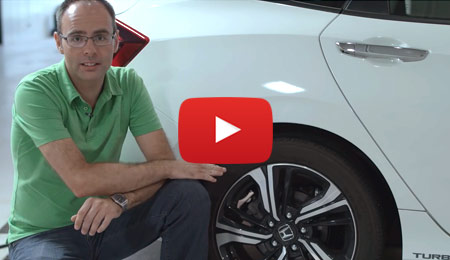All you need to know about tire pressure

Check your tire pressure often and in all seasons! It can help prevent unpleasant surprises.
Serious consequences
One thing is sure: incorrect air pressure in your vehicle’s tires can have serious safety consequences.
Underinflated tires

An underinflated tire can result in unstable vehicle handling, and may even overheat and explode.
Not only that, but driving with an underinflated tire will also reduce the tire’s life expectancy and increase your vehicle’s fuel consumption.(Video in french only)
Overinflated tires
When a tire is overinflated, only the central part of its tread meets the road surface. This reduced contact means the tire’s grip on the road is weaker, which of course results in handling problems: the vehicle responds poorly to steering manoeuvres and becomes harder to stop. Excessive tire pressure also causes more wear on steering and suspension components and cuts down on a tire’s lifespan.
Checking every month is important...
CAA-Quebec therefore recommends checking your tires once a month to ensure you always follow the pressure recommended by the manufacturer. This simple check only takes a few moments and can be performed with a manometer, or tire gauge available from any big-box store or at CAA-Quebec Boutique.
...especially in winter
It’s even more essential to check your tire pressure regularly when it gets cold out. Tires automatically lose 1 PSI for every 6°C drop in temperature. If it was 10°C out when your winter tires were mounted in October, they’ll have lost 5 PSI by the time the mercury drops to a frosty -20°C!
And you can’t always tell when your tires are underinflated. It’s a drag to do in the dead of winter, but a quick pressure check is a smart way to avoid risks and headaches.
Proper tire pressure
The manufacturer of your vehicle has determined that at a given pressure—taking into account vehicle weight and other characteristics—stability, road handling, load capacity and fuel consumption will be optimal. The recommended tire pressure appears on a label found on one of the vehicle doorframes, in the glove compartment, or on the fuel tank access door, or in the owner’s manual.
How to measure properly
Tire pressure must be checked when the tires are “cold”, that is, when the vehicle has not been driven, or has been driven for only a short time. If the tires have heated up, the reading may be incorrect.
- Remove the cap from the tire inflation valve.
- Place the gauge on top of the valve and press firmly. If the gauge is incorrectly positioned, you will hear air escaping. If it is held correctly in place, you will be able to read the tire’s air pressure on the stem of the gauge (or on its display, if you are using a digital model).
- Check that the pressure indicated by the gauge matches the recommended pressure. If it is too low, inflate the tire, using a compressor if you have one; otherwise, use the public pump at a gas station.
- If the tire is overinflated, simply use the appropriate device on the gauge (usually a small built-in stem) to push down on the valve spring and release the surplus air.
- If your tires are inflated with nitrogen, be sure to use nitrogen and not air (except in an emergency) so as not to lose the benefits that nitrogen inflation provides.
Lastly, don’t forget to also check the air pressure in your vehicle’s spare tire, if it is equipped with one.


Benefit from personalized advice
Do you have questions about gas-powered or electric vehicles, driving, or need recommendations to find an Approved Auto Repair Service?